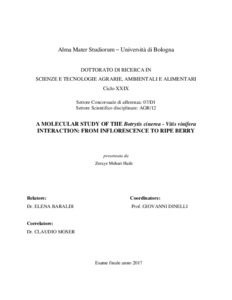Haile, Zeraye Mehari
(2017)
A Molecular Study of the Botrytis Cinerea- Vitis Vinifera
Interaction: from Inflorescence to Ripe Berry, [Dissertation thesis], Alma Mater Studiorum Università di Bologna.
Dottorato di ricerca in
Scienze e tecnologie agrarie, ambientali e alimentari, 29 Ciclo. DOI 10.6092/unibo/amsdottorato/7805.
Documenti full-text disponibili:
![[img]](http://amsdottorato.unibo.it/7805/1.hassmallThumbnailVersion/Haile_Zeraye%20Mehari_Tesi.pdf)  Anteprima |
|
Documento PDF (English)
- Richiede un lettore di PDF come Xpdf o Adobe Acrobat Reader
Disponibile con Licenza: Salvo eventuali più ampie autorizzazioni dell'autore, la tesi può essere liberamente consultata e può essere effettuato il salvataggio e la stampa di una copia per fini strettamente personali di studio, di ricerca e di insegnamento, con espresso divieto di qualunque utilizzo direttamente o indirettamente commerciale. Ogni altro diritto sul materiale è riservato.
Download (5MB)
| Anteprima
|
Abstract
Grapes quality and yield are affected by bunch rot disease caused by the necrotrophic fungus Botrytis cinerea. The fungus often remains quiescent from bloom until maturity and egresses at ripe where it causes bunch rot. Here, it is reported molecular analyses of the interaction between B. cinerea and the flower/berry of Vitis vinifera, using confocal microscopy and integrated transcriptomic and metabolic analysis. Flowers from fruiting cuttings of the cv. Pinot Noir were infected with GFP labeled B. cinerea and samples taken at 24 and 96 hours post inoculation (hpi), at 4 weeks post inoculation (wpi), and at 12 wpi were studied. The observed penetration of the flower epidermis by B. cinerea coincided with increased expression of fungal virulence genes. Flowers responded with defense reactions involving PR proteins, stilbenoids, reactive oxygen species and cell wall reinforcement. At 96 hpi the transcriptional reaction appeared largely diminished both in the host and in the pathogen. Afterwards, infected berries continued their developmental program without any visible symptom. Nonetheless, the expressed quiescent fungal transcriptome highlighted that the fungus was modifying its cell wall to evade plant chitinases. Hard-green berries maintained activated response, based on the expression of several PR family genes and genes involved in monolignol, flavonoid and stilbenoid biosynthesis pathways. At 12 wpi, the transcripts of B. cinerea in the pre-egressed samples showed that virulence-related genes were expressed again. The egressed B. cinerea expressed almost all virulence and growth related genes. In response to egression, ripe berries reprogram different defense responses, though futilely. In conclusion, the defense responses occurring in the grapevine flower and hard-green berry were able to restrict invasive fungal growth. However, the pathogen was able to perceive and exploit ripening associated modifications and favorable external conditions to recover an active metabolism and pathogenic activity, and eventually caused bunch rot.
Abstract
Grapes quality and yield are affected by bunch rot disease caused by the necrotrophic fungus Botrytis cinerea. The fungus often remains quiescent from bloom until maturity and egresses at ripe where it causes bunch rot. Here, it is reported molecular analyses of the interaction between B. cinerea and the flower/berry of Vitis vinifera, using confocal microscopy and integrated transcriptomic and metabolic analysis. Flowers from fruiting cuttings of the cv. Pinot Noir were infected with GFP labeled B. cinerea and samples taken at 24 and 96 hours post inoculation (hpi), at 4 weeks post inoculation (wpi), and at 12 wpi were studied. The observed penetration of the flower epidermis by B. cinerea coincided with increased expression of fungal virulence genes. Flowers responded with defense reactions involving PR proteins, stilbenoids, reactive oxygen species and cell wall reinforcement. At 96 hpi the transcriptional reaction appeared largely diminished both in the host and in the pathogen. Afterwards, infected berries continued their developmental program without any visible symptom. Nonetheless, the expressed quiescent fungal transcriptome highlighted that the fungus was modifying its cell wall to evade plant chitinases. Hard-green berries maintained activated response, based on the expression of several PR family genes and genes involved in monolignol, flavonoid and stilbenoid biosynthesis pathways. At 12 wpi, the transcripts of B. cinerea in the pre-egressed samples showed that virulence-related genes were expressed again. The egressed B. cinerea expressed almost all virulence and growth related genes. In response to egression, ripe berries reprogram different defense responses, though futilely. In conclusion, the defense responses occurring in the grapevine flower and hard-green berry were able to restrict invasive fungal growth. However, the pathogen was able to perceive and exploit ripening associated modifications and favorable external conditions to recover an active metabolism and pathogenic activity, and eventually caused bunch rot.
Tipologia del documento
Tesi di dottorato
Autore
Haile, Zeraye Mehari
Supervisore
Co-supervisore
Dottorato di ricerca
Ciclo
29
Coordinatore
Settore disciplinare
Settore concorsuale
Parole chiave
Vitis vinifera, Botrytis cinerea, quiescence, defence response, egression, bunch rot, RNA-Seq
URN:NBN
DOI
10.6092/unibo/amsdottorato/7805
Data di discussione
30 Gennaio 2017
URI
Altri metadati
Tipologia del documento
Tesi di dottorato
Autore
Haile, Zeraye Mehari
Supervisore
Co-supervisore
Dottorato di ricerca
Ciclo
29
Coordinatore
Settore disciplinare
Settore concorsuale
Parole chiave
Vitis vinifera, Botrytis cinerea, quiescence, defence response, egression, bunch rot, RNA-Seq
URN:NBN
DOI
10.6092/unibo/amsdottorato/7805
Data di discussione
30 Gennaio 2017
URI
Statistica sui download
Gestione del documento:


 Login
Login
